Adam Yamey's Blog: YAMEY, page 163
April 29, 2021
Artists in Hampstead: London’s Montmartre
JUST AS MONTMARTRE in Paris attracted artists, particularly painters, so did Hampstead in north London. Best known amongst these were John Constable (1776-1837) and Sir George Romney (1734-1802), who both resided in Hampstead. Constable lived in various parts of Hampstead including Well Walk and Lower Terrace. Reynolds had a fine house on Holly Hill. Since the 18th century, many painters and sculptors have either worked and/or lived in Hampstead.
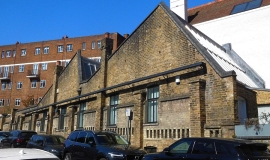 Studio of the painter Mark Gertler in Hampstead
Studio of the painter Mark Gertler in HampsteadAlthough I have visited Hampstead often over a period of more than six decades, it was only yesterday in April 2021 that I first noticed what looks like a small industrial unit with two sloping roofs each with large skylights along one side of Well Road. This is not what it looks like but was formerly artists’ work places, named Well Mount Studios. A commemorative plaque affixed to the building records that the painter Mark Gertler (1891-1939) lived here. I first became aware of this artist when visiting an exhibition at Dulwich Art Gallery in 2013 (www.dulwichpicturegallery.org.uk/about/press-media/press-releases/dulwich-picture-gallery-presents-nash-nevinson-spencer-gertler-carrington-bomberg-a-crisis-of-brilliance/) in which pictures painted by artists who had studied at London’s Slade School of Art were displayed. Amongst these artists was Dora Carrington (1893-1932), whose brief sexual relationship with Gertler was the inspiration for a novel, “Mendel”, by Gilbert Cannan. Gertler painted Cannan in about 1916.
Gertler lived at several other addresses in Hampstead in addition to Well Road: The Vale of Health, 13a Rudall Crescent, and 53 Haverstock Hill (https://rosemaryhallart.wordpress.com/2014/07/06/artists-in-hampstead-part-iii/). His parents were poor Jewish immigrants. Gertler was born in London’s Spitalfields in 1891. Soon after that, his parents and the family returned to Austria-Hungary in 1892, settling in Przemyśl in Austria-Hungary (now in Poland). Then, in 1896, the family returned to London. Mark displayed great artistic talent as a child and in 1906, after leaving school, he studied art first at the Regents Street Polytechnic and then, at the recommendation of the artist Sir William Rothenstein (1872-1945), who lived in Hampstead between 1902 and 1912, he entered The Slade. Rothenstein lived at 12 Church Row, where he painted “Mother and Child” in 1903 (www.tate.org.uk/art/artworks/rothenst...).
While at the Slade, Mark was a contemporary of artists including Paul Nash, Edward Wadsworth, C. R. W. Nevinson, Stanley Spencer, Isaac Rosenberg, and Morris Goldstein (https://en.wikipedia.org/wiki/Mark_Gertler_(artist)). During his time at the Slade, he met and became infatuated with Dora Carrington.
Mark moved to Hampstead in late 1914. According to Caroline Maclean in her book about the Hampstead Modernists, “Circles & Squares”, Mark moved into the studios near New End, i.e. Well Mount Studios, in 1915, and painted his well-known “Merry-Go-Round” in 1916. This painting that is in the collection held by the Tate Gallery was inspired by a special funfair that was held on Hampstead Heath in 1915 on behalf of wounded soldiers and sailors (www.tate.org.uk/art/artworks/gertler-merry-go-round-t03846). The painting is believed to reflect that artist’s reaction to war. He was a conscientious objector. He had written to his patron, the art collector Edward Marsh (1852-1953):
“’I am I believe what you call a “passivist”. I don’t know exactly what that means, but I just hate the war”.
Well Mount Studios were built in the late 19th century (http://hughcullum.com/portfolio/well-mount-studios/). The building’s exterior is not particularly attractive but its interior was tastefully renewed in 2003.
Gertler contracted tuberculosis in 1920. He married Marjorie Greatorex Hodgkinson ten years later and they had a son in 1932. Both he and his wife suffered bad health and Mark’s mental stability deteriorated during the 1930s. Tragically, he committed suicide in 1939 in his studio which was by then at 5 Grove Terrace, Highgate Road (near Parliament Hill Fields), London (https://artuk.org/discover/stories/the-genius-of-the-place-mark-gertler).
A relatively early 20th century artistic arrival in Hampstead, Gertler was followed by a host of other 20th century artists from all over Britain and elsewhere. These included well-known creators such as Barbara Hepworth, Laszlo Moholy-Nagy, Ben Nicholson, Henry Moore, Roland Penrose, Lee Miller, and many others. When I was at the Hall School at Swiss Cottage between 1960 and 1965, one of my fellow pupils was a son of the graphic designer Frederick Henri Kay Henrion (1914-1990) and his wife the sculptor Daphne Hardy Henrion (1917-2003), who was once a close friend of the writer Arthur Koestler (1905-1983). The Henrions lived in Pond Street for twenty years from about 1946 onwards. They had two sons, one of whom attended The Hall with me. I do not recall his first name because at that school everyone addressed each other by their surnames.
Far less well-known than any of the above-mentioned artists was my mother’s cousin Dolf Rieser (1898-1983; https://dolfrieser.com/biography/). Dolf, a fine etcher and engraver, lived in Sumatra Road, West Hampstead. In the late 1970s and early 1980s, I used to attend his inspiring classes in the large studio in his house. Some examples of his prolific output are in important collections such as the Victoria and Albert Museum and the Imperial War Museum, both in London. Apart from being a great judge of composition, my relative Dolf was highly inventive as his son Richard noted:
“Dolf was innovative, experimenting with plaster prints, silk scarf prints for Liberty’s, printing on leather, printing on plastic paper to be laminated table-tops and on fibre glass to create translucent panels. He even designed for the whole side of a building a ‘print’ to be sand blasted into the concrete, at a university Witwatersrand in the form of a Bushman cave painting. Dolf worked with a plastics expert, Richard Wood, to develop the laminated hand made prints and the prints on fibre glass. The prints went off to the factory to be laminated, but the fibre glass he rolled onto the plate which had been inked with specially prepared plastic pigments, then had resin spread on and then another layer of fibre glass. The resin warmed up and emitted a sweet smell, like honey, and when it was set it could be peeled off the plate. A light could be put behind to give a translucent image.” (https://dolfrieser.com/a-personal-memory/)
Working in Dolf’s studio once a week for a few years helped made me feel like I was involved in the Hampstead art scene at least a little bit.
During my childhood in the 1950s and 1960s, when we often visited Hampstead, there used to be an annual summer fair of local artists’ works held on the wide pavement of Heath Street near to Whitestone Pond. Most of these artists were far less well-known than the likes of Gertler or even my relative Dolf Rieser, but seeing the exhibition helped to imprint Hampstead’s rich association with visual art firmly in my then young mind.
April 28, 2021
Pets and musical instruments in north London
CLAVICHORDS, HARPSICHICHORDS, VIRGINALS, and other historical musical instruments can be viewed whilst walking through the rooms of Fenton House in Hampstead. When I first visited the house in the second half of the 1960s, anyone could touch the keyboards of these antique instruments even if they had not the faintest idea how to play them. Some visitors with musical skills used to play music on them. Nowadays, visitors are not permitted to touch the instruments without special permission from the management of this house maintained by the National Trust.
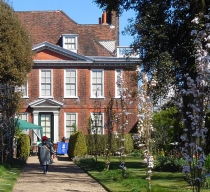
Built in about 1693 (https://historicengland.org.uk/listing/the-list/list-entry/1378648), Fenton House is named after Philip Robertson Fenton, a wealthy Riga merchant who exported goods to the UK. He bought it in 1793. Prior to getting its current name Fenton House was known as Ostend, then Clock House. Members of the Fenton family lived there until about 1835. Later residents included a Mrs Selwyn, and, according to Baratt, a historian of Hampstead, also:
“…Mr. Vaughan Davis; Thomas Turner, Treasurer of Guy’s Hospital and the Hon. Mrs. Margaret Murray, afterwards Baroness Gray in her own right, and great-aunt of the sixth Lord Mansfield. Lady Abercrombie also resided in this mansion for a time. Both Baroness Gray and Lady Abercrombie had been ladies-in-waiting to Queen Victoria, and her Majesty visited them on different occasions at Fenton House.”
Lady Binning, widow of Brigadier-General George Baillie-Hamilton (1856-1917), whom she married in 1892, bequeathed Fenton House to the National Trust in 1952, the year of her death.
The musical instruments within the house were collected by Major George Henry Benton Fletcher (1866-1944), who had a varied career including social work; archaeology; art and book illustrating; and soldiering. His collection of keyboard instruments was housed in various locations including Old Devonshire House in Holborn, where he lived until it was destroyed by the Luftwaffe in 1941. Fortunately, his collection of musical instruments was saved because he had evacuated them to Gloucestershire earlier. In 1937, he had donated his house and the collection to the National Trust on the condition that he could live there for the rest of his life. His collection of musical instruments was moved to Fenton House in 1952.
At present (April 2021), visitors cannot enter the house, but are able to see the small but lovely gardens. The rear gardens are on two levels, the lower of these includes a small orchard. The upper level is a lawn surrounded by flower beds. At one end of the lawn, there is a sculpture of a standing figure holding a long, slender staff in his right hand and dressed in what looks like 18th century attire.
In one of the flowerbeds, I noticed three small carved stones that look like small tombstones. Two of these have become almost submerged in the soil. The third has the following carved on it:
“ BE??? 1933-1944”, the question marks being letters that were too indistinct to read. The stones reminded me of the small gravestones that I have seen in the pet cemetery on the edge of London’s Hyde Park. The volunteers working at the house confirmed that these stones mark burial sites of pets, who resided at Fenton House. The stone with a visible inscription most probably commemorates a pet owned by Lady Katharine Binning (née Salting), who bought the house in 1936 (https://alondoninheritance.com/london-buildings/fenton-house-hampstead/). As for the other two stones, without digging them up, which would not find favour with the National Trust, we cannot know when they were placed, or by whom. As they are the same design and material as the one inscribed stone, maybe it would be safe to guess that they mark the burial places of other pets owned by Lady Binning.
I look forward to entering Fenton House when covid19 regulations are relaxed in the future. From what I remember of earlier visits, its rooms are filled with interesting exhibits in addition to the lovely old musical instruments.
April 27, 2021
Glass, iron, and Syon
KEW GARDENS CONTAINS several magnificent Victorian plant houses made mainly of glass and iron. These include: The Palm House built 1844-1848; The Waterlily House built 1852; and The Temperate House built in about 1859. Although they are early examples of massive glass and iron structures for the cultivation of plants, they are not the earliest. The conservatory in the gardens of nearby Syon House predates them, having been built in 1827, ten years before Queen Victoria came to the throne. As a work of architecture, it rivals the best of those Victorian ‘glasshouses’ that can be seen at Kew.
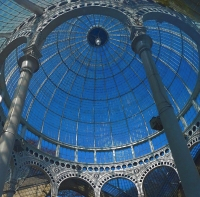 The Grand Conservatory at Syon
The Grand Conservatory at SyonWe had parked in the grounds of Syon House several times before we visited its gardens in April 2021 and each time, I noticed the large glass and iron dome towering over the high garden walls. Until we entered the gardens, I had not realised that this splendid dome is attached to one of the most attractive plant conservatories that I have ever seen.
The extensive gardens of Syon House were landscaped by Lancelot ‘Capability’ Brown (1716-1783) in 1760 but were replanned in the 19th century. The architect Charles Fowler (1792-1862), who designed the market buildings in London’s Covent Garden, designed The Great Conservatory at Syon Park. It was built for Hugh Percy the Third Duke of Northumberland (1785-1847), who served as Lord Lieutenant of Ireland under the Duke of Wellington from 1829 to 1830 (https://en.wikipedia.org/wiki/Hugh_Percy,_3rd_Duke_of_Northumberland).
Writing in 1876, James Thorne, author of “Handbook to The Environs of London”, noted:
“The Great Conservatory designed by Fowler is in the form of a wide crescent, with pavilions at the extremities, and a lofty central dome. The centre, 100 feet long, is a tropical house, and is said to contain the finest collection of tropical plants in any private establishment in England. It is noteworthy that here only in this country has the cocoanut palm fully ripened …”
Thorne also noted that the vases on pedestals on the terrace in front of the conservatory were carved by Grinling Gibbons (1648-1721). The circular pool in front of the conservatory has a statue of Hermes (Mercury), which is a copy of one by the Italian sculptor Giambologna (1529-1608).
Although we were unable to enter The Great Conservatory, we could see most of it through its clean windows. The central dome is supported by a ring of perforated semi-circular arches held aloft by slender iron pillars. Even without entering it, the central area of the building can be seen to be a beautifully designed, airy space. Though not as crowded with plants as the conservatories at Kew Gardens, the one at Syon contains a collection of palms, cactuses, and other warm weather plants, mostly large and well-established. Unlike the glasshouses at Kew, much of the rear wall of The Great Conservatory is constructed with brickwork instead of glass and iron.
Much time can be spent enjoyably exploring the lovely gardens at Syon House, but despite their beauty, the pièce-de-rèsistance is without doubt The Great Conservatory, an impressive and beautiful example of construction in glass and iron. It is well worth purchasing an admission ticket even if only to see and admire this great work of Regency architecture.
April 26, 2021
Boston, but not in Massachusetts
THE NAME BOSTON is often associated with a revolutionary tea party in a former British possession. Some might also associate it with a town in Lincolnshire. And Londoners might connect it with a tube station on the Piccadilly Line of the London Underground. The station, which is a stop on the line to Heathrow Airport is Boston Manor, a place which I first visited in April of this year (2021).
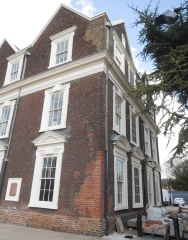
In the case of Boston Manor, the name Boston is derived from an older name ‘Bordeston’, which comes from the word ‘borde’, meaning ‘boundary’. Another etymology of the name, which is unrelated to that of the Boston in Lincolnshire, is that it derives from the name of a Saxon farmer named ‘Bord’. Whatever the origin of the name, Boston Manor, the house and its lovely gardens, stand on the border between Hanwell and Brentford.
Until the Priory of St Helens in Bishopsgate was suppressed in 1538 (https://en.wikipedia.org/wiki/St_Helen%27s_Church,_Bishopsgate), the Manor of Bordeston was owned by it. King Edward VI granted it to Edward, Duke of Somerset (1500-1552), Lord Protector of England during the earlier part of Edward VI’s reign, and later it reverted to the Crown. In 1552, Queen Elizabeth I gave the manor to the Earl of Leicester, who immediately sold it to the merchant and financier Sir Thomas Gresham (c1519-1579). After several changes of ownership, the property was sold in 1670 to the City merchant James Clitherow (1618-1681; www.bhsproject.co.uk/families_clitherow.shtml). James demolished the existing manor house. He modified and enlarged Boston House, originally built by Lady Reade in 1622 in the Jacobean style. This house with three gables still stands but is closed as it is undergoing extensive repairs. It looks out onto grounds planted with fine trees, many of them cedars of Lebanon. The grounds that include a small lake slope down towards the River Brent. The house and grounds, Boston Manor Park, remained in the possession on of the Clitherow family until 1923, when Colonel John Bourchier Stracey-Clitherow (1853-1931) sold the house and what was left of the estate (after some of it had been sold to property developers) to the then local authority, Brentford Urban District Council. During his military career, this gentleman was taken prisoner during the ill-fated Jameson Raid in South Africa, a prelude to the Second Anglo-Boer War.
Before the Clitherows began selling off their land at Boston manor, there was a house in the grounds called ‘Little Boston’. It stood until the early 1920s when it was sold to a developer named Jackman, who demolished it to build houses now standing on Windmill Road (https://littleealinghistory.org.uk/node/6). John Quincy Adams (1767-1848), who became the sixth president of the USA in 1825, resided in Little Boston house between 1815 and 1817 whilst he was American minister to Britain during that period. Adams was born in Massachusetts. So, it seems fitting that he lived in a house and an estate both bearing the name of an important city in that American state.
On our way to see our friend who took us to see Boston Manor House and Park, we drove along a road named in memory of the Clitherow family. Sadly, what with the building works and covid19 restrictions, we were unable to view the fine interior of Boston Manor House. However, the garden and its lake, where we spotted its resident tortoise sunning itself on a log, proved to be a lovely surprise, well worth visiting … and you need not cross the Atlantic to get there from London.
April 25, 2021
Growing in the village stream
MANY PEOPLE ENJOY eating watercress. I quite like it, but it is not my favourite. I prefer eating its close and more piquant relatives: mustard and wasabi. As its name suggests, watercress is an aquatic plant that lives in a watery environment. It could almost be considered an edible water weed. This April (2021) we visited Ewelme, a small village in Oxfordshire, where watercress is cultivated in the river that runs through it. We had come to Ewelme to see its alms-houses and school, which were built in about 1437 and are still being used for their original purposes. I will relate more about these in the future.
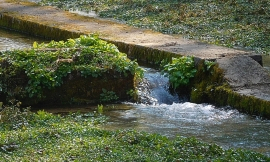
On our way to the village, we met some cyclists, who told us about the watercress cultivation in Ewelme and recommended that we took a look at the set-up. I was interested to see it as I had never (knowingly) seen watercress growing. Also, I was curious because I have often walked past Willow Cottages on Willow Road in Hampstead. It was in this row of dwellings that Hampstead’s watercress pickers lived many years ago. They gathered the crop from streams flowing on nearby Hampstead Heath.
The name Ewelme is derived from the Old English ‘Ae-whylme’ meaning ‘waters whelming’ or ‘source of a stream or river’. In the early 13th century, the place was known as ‘Eawelma’. The spring after which the village is named is just north of Ewelme. Water from the spring that flows through the village is in Ewelme Brook, which is a short tributary of the nearby River Thames. It meets the Thames 1.2 miles upstream from Wallingford Bridge. Watercress grows best in alkaline water such as flows in Ewelme Brook, which rises in the chalky Chiltern Hills.
The watercress beds can be found in Ewelme near the northern end of the High Street, northwest of the attractive village pond that forms a part of the Brook. They were established in the 19th century. Watercress from Ewelme was taken to Wallingford from where it was carried further afield by train. In 1881, the idea of a rail link between Ewelme and Wallingford was mooted, but the line was never built. It was in that year that:
“…Smiths of Lewknor and South Weston, who were established at Brownings by 1881, and created cress beds along the roadside stream probably in stages. The business continued until 1988, with cress initially transported from Watlington station for sale in the Midlands, Covent Garden, and Oxford.” (www.british-history.ac.uk/vch/oxon/vol18/pp192-234)
The Ewelme watercress beds were abandoned in 1988 but restored by the Chiltern Society after 1999. This organization continues to look after them (https://chilternsociety.org.uk/event/chiltern-society-ewelme-watercress-beds-conservation-volunteers-6/2019-02-02/).
The watercress beds at Ewelme are a series of rectangular enclosures in a widened part of the stream. The cress grows, floating on the water in the enclosures. Pairs of enclosures are arranged sequentially like shallow steps in a staircase. The shallow water flows rapidly from one enclosure to the next through small gaps in the stone barriers that demarcate them. Swarms of watercress leaves on their stems almost fill each of the enclosures, deriving nutrients and water from the continuously changing water flowing through their roots. I imagine that picking the crop involves wading in the watery watercress beds.
Although Oxfordshire is no longer one of the major counties for watercress cultivation, what can be seen at Ewelme is pleasing to the eye. The counties where most of this plant is now grown include Hampshire, Dorset, Wiltshire, and Hertfordshire (https://en.wikipedia.org/wiki/Watercress). Alresford in Hampshire, near Winchester, is known as the UK’s watercress capital.
Although I am not keen on raw watercress, I prefer it served in a soup. My late aunt used to make a superb watercress soup using fresh watercress added at the last minute to a homemade vegetable stock. We have tried making it with meat stock, but this was not nearly as nice because the fresh taste of the almost uncooked watercress gets masked by the flavour of the stock. With this small bit of culinary advice, I will leave the watercress beds of Ewelme and wish you “bon appetit”.
April 24, 2021
A historic town hall
FIRST WORLD WAR veteran William Frederick Stone died aged 108 in January 2009. He moved to Watlington in Oxfordshire in 1986 and lived the rest of his life in this small town. A popular figure in the town, he would have often passed the place’s Town Hall, which had been in existence even longer than him.
The name Watlington is probably derived from ‘tun’, meaning ‘fence’ or ‘enclosure’, and the people of ‘Wacol’ or ‘Waecol’, who also gave their name to the famous old road known as Watling Street. The town is close to another ancient cross-country route, the Icknield Way (https://en.wikipedia.org/wiki/Icknield_Way). There is evidence that there was a settlement at Watlington in the 6th century AD. The current street layout was already established by the 14th century and that there were inns in the town by the following century. During the English Civil War (1642-1651), Parliamentary troops were billeted in the town on the night before the Battle of Chalgrove Field on the 18th of June 1643, a battle in which their opponents, the Royalists, were victorious (www.britishbattles.com/english-civil-war/battle-of-chalgrove/).
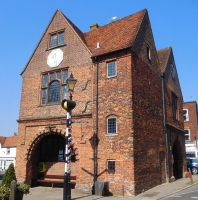
Twenty-one years after the battle, in 1664, Watlington’s town hall was built by Sir Thomas Stonor (c1626-1683). He lived at Stonor Park, which is 4.7 miles south east of Watlington. The Stonor family were Roman Catholics and retained their faith throughout the Reformation and suffered for that during the 16th and 17th centuries.
The brick town hall is unusual in that no two of its sides are equal in length and none of its corners are right angles (www.watlingtontownhall.com/history.html). Part of the ground floor is an arcade open to the outside air. This area was formerly used to hold markets. The first floor of the building served as a grammar school in the 19th century. The clock mechanism on the second floor is said to have come from the studios of the architect of St Paul’s Cathedral, Christopher Wren. This is not the only timepiece on the outside of the building. The other is a sundial, which has been gilded with 24 carat gold. The town hall was extended in the later 17th or early 18th century (https://britishlistedbuildings.co.uk/101369012-town-hall-watlington#.YH28eehKhPY) and was restored faithfully in the 20th century. Currently, the first-floor room, the former school, and beneath it, the under croft, are available for hire for social and other functions.
We came across the town hall quite by chance when driving home from visiting the Maharajah’s Well at Stoke Row. Today, we revisited the town on our way back from seeing several other places in Oxfordshire, about which I hope to tell you in the near future. Driving through England on roads other than motorways takes one through small towns and villages and many of these have features worth stopping to examine. Apart from the town hall, Watlington is a charming old place with several half-timbered buildings, cafés, and shops. Once again, a day trip to the countryside near London has proved rewarding.
April 23, 2021
A beautiful bank
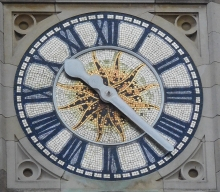
LOVERS OF ARCHITECTURE will find much to enjoy amongst the buildings that fill the historic centre of the university city of Cambridge. Amongst the sea of old colleges, which are rich in fine architectural features, there are some attractive buildings whose existence are not solely due to the requirements of academia. One of these stands at the southern end of Sidney Street. Formerly Foster’s Bank, this picturesque edifice faced with alternating stripes of red and white and topped with a highly decorative clock tower, now houses a branch of Lloyd’s Bank.
Ebenezer Foster (1776-1851) and his brother Richard, both born in Cambridge, founded their bank in 1804. The bank was originally founded for the workers at the three mills that the Fosters owned (www.findagrave.com/memorial/181142444/ebenezer-foster). Because the university would not allow the Fosters to build railway lines to their mills, they constructed another mill close to the existing railway lines. This mill is now called Spillers Mill. The Foster family lived at Anstey Hall in Trumpington (near Cambridge) from 1838 to 1941. Ebenezer died in Trumpington. Ebenezer was Mayor of Cambridge in 1836, and later a county magistrate, then the High Sheriff in 1849. In addition to other public positions, he was a governor of Addenbrooke’s Hospital. Ebenezer’s obituary in “Cambridge Independent Pres” on Saturday the 31st of May 1851 noted:
“Mr. Foster was at the head of the first banking and mercantile establishments in the town. It is unnecessary, therefore, to say that his life was one of great activity and usefulness; and it is not too much to say that in every occupation, whether public or private, his conduct commanded universal respect.”
Before 1891, Fosters Bank was housed on Trinity Street in what was once the Turk’s Head:
“The rather attractive Tudor shop on Trinity Street now occupied by a clothes shop was once the Turk’s Head Coffee House, one of the earliest coffee houses in the country (17th century). It was much frequented by students. The upper floors later became the Turk’s Head Carvery, but it is now entirely given over to floral prints. The building was once the home of Fosters’ Bank, which later moved …” (www.cl.cam.ac.uk/~ckh11/cam.html).
Years ago, in the late 1960s, four of us, three friends and myself, ate a meal at the Turks Head. The bill for the four of us came to 14/6 (72.5pence) and we gave the waiter 15/- (15 shillings: 75 pence). My friends were horrified when I told the waiter:
“Keep the change.”
For, even in those far-off days, sixpence (2.5 pence) was a rather mean tip for a bill of 14/6.
In 1891, the bank building at the south end of Sidney Street, once Foster’s now Lloyd’s, was completed. It was designed by the architects A and P Waterhouse. Alfred Waterhouse (1830-1905) was the eldest of eight children. One of his siblings, Edwin Waterhouse (1841–1917), was one of the founders of the accountancy company Price Waterhouse (now incorporated into PWC). Alfred’s son Paul (1861-1924) joined his father’s architectural practice in 1884, becoming a partner in 1891, the year that the Foster’s Bank building was put up in Sidney Street.
Alfred Waterhouse and his practice were responsible for the design of many impressive buildings in the Victorian era. One of them, which is very well-known, is London’s Natural History Museum. Slightly less famous but equally impressive is the Prudential Assurance Building in London’s Holborn. This building is opposite numbers 337 and 338 High Holborn, which survived the Great Fire of London of 1666, and were restored by Waterhouse. Apart from the bank in Cambridge and the Cambridge Union building, he also designed buildings associated with the following colleges: Jesus, Gonville and Caius, Pembroke, Girton, and Trinity Hall. The bank in Cambridge is one of seven designed by Alfred Waterhouse.
I have entered the former Foster’s Bank only once. The glass-ceilinged banking hall is a riot of colour, its surfaces covered by tiles with sculpted surfaces. The octagonal clock tower is topped with a sharply pointed octagonal roof, one of the city’s many spires. The clock faces with their Roman numerals are made with tiling in several colours. Although now a branch of Lloyds, the name Foster can still be seen clearly above the main doorway.
When you next visit Cambridge, by all means admire Kings College Chapel and other architectural gems within the various colleges, but do spare some time to enjoy the former Foster’s Bank building on Sidney Street before visiting the nearby marketplace, which I always enjoy.
April 22, 2021
Dame Jane lies stone cold in the church
HER HEAD RESTS ON her stone-cold right hand with her elbow on a carved alabaster cushion. Her left hand is held lightly and limply against her left breast. She is a carved alabaster effigy of Dame Jane Cotton (1630-1692), widow of Sir John Cotton of Landwade (1615-1689). This sculpture of Jane Cotton lies against the north wall of the chancel of the Church of St Mary Magdalene in the village of Madingley, close to Cambridge. The church is open until 4pm most days and we got there by 3.45 pm a few days ago in April 2021. So, we were able to have a good look at the interior of this building whose construction commenced in the late 13th century (https://historicengland.org.uk/listing/the-list/list-entry/1127740).
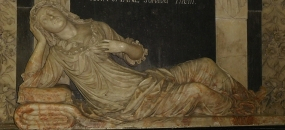
Jane Cotton, who reclines close to the high altar, was the daughter and sole heir of Edward Hinde (c1598-1631) of the Parish of Madingley. Edward lived at Madingley Hall (www.thepeerage.com/p34969.htm#i349687), which is a few yards uphill from the church. Sir John Cotton did well by marrying Jane because by doing so, he acquired the manor of Madingley.
Sir John Hinde (or ‘Hynde’; c1480-1550; see: http://www.geni.com/people/Sir-John-Hynde-MP/6000000090158312935), Serjeant-at-Law and Member of Parliament, had been buying land at Madingley since the 1520s (www.british-history.ac.uk/vch/cambs/vol9/pp166-171). In 1544, the manor of Madingley, which had been held by several trustees for about 100 years, was bestowed on him by law. He commissioned the building of the lovely Madingley Hall, which was constructed between 1543 and 1547. Edward Hinde, Jane Cotton’s father, was a grandson of Sir John Hinde.
Sir John left Madingley to his son Francis, who left it to his son William, who married a widow, Elizabeth. When William died childless in 1606, his widow Elizabeth took over all of the Hinde estates. She remarried and leased Madingley Hall to Edward, who was son of William Hinde’s brother Edward (died 1633).
Jane’s father Edward (died 1633) settled his lands on his eldest son Anthony, who died before him, fighting in Denmark, in 1612, when Denmark was fighting Sweden for control of part of Norway. Anne, Anthony’s widow, ‘sold’ her interests in the lands to her father-in-law Edward (died 1633). Anne and Anthony had a son Edward, to whom Anthony’s father (Edward, died 1633) had left all his lands, but the grandson, Edward, died in an accident in 1631. Jane Hinde then became the heir to her father’s lands. Had Anthony and his son not pre-deceased Jane’s father, she would not have come into possession of the Hinde’s estates, and neither would have they come into the hands of Sir John Cotton. The lands at Madingley remained in the Cotton family until the beginning of the 20th century.
Sir John, husband of Jane, was buried with his ancestors at Landwade in eastern Cambridgeshire. His daughter Jane is interred in the church at Madingley. Her monument stands near the northwest corner of the nave. She is depicted kneeling with a small book in her left hand. Jane was a spinster. She died in 1707. Not far from her monument stands a lovely carved stone font. Covered with geometric decoration, this was made in the 12th century and probably stood in an earlier version of the church. Nearby, the internal walls of the bell tower are decorated with damaged sculptures made of wood. They are:
“… probably the survivors of the cherubim, perhaps on the nave roof, whose removal William Dowsing ordered in 1644.” (www.british-history.ac.uk/vch/cambs/vol9/pp173-176)
Although there is much to enjoy in the church at Madingley, it was Lady Jane Cotton’s reclining effigy that most sparked my curiosity. Looking into what is known of Jane’s heritage has revealed a little bit about the complexities faced by the ‘landed gentry’ when they considered who was to inherit their land.
The families mentioned are what some might describe, often expressing a sense of deference, as ‘old families’. What this means is that the family has sufficient documentary information to trace it back, maybe over many centuries, for many generations. Well, if you think about it ‘old families’ are no different from other families because all of them must go back an awfully long way in history, even if the documentary evidence no longer exists.
April 21, 2021
After effects
MY FIRST TRIP TO TURKEY was in 1960. I had just finished primary school and was about to start preparatory school (8 to 13 years old) after the summer holidays. That summer we were travelling to Turkey, to Istanbul, where my father was a delegate at a conference. It was deemed necessary to have vaccinations to reduce the risk of contracting typhoid and cholera.

Our family doctor’s surgery in London’s Golders Green was close to my primary school. I had decided to get my ‘jab’ and then to go to school to help organise the annual sports day. When I arrived, I was assigned a task related to the high jump competition. At first, all went well. Then, after a few minutes, I began shivering and felt lousy. I excused myself and made my way home. I spent the rest of the day and the following in bed and the arm in which I was injected felt both painful and heavy. A few weeks later, I was given the second of the combined cholera and typhoid jabs. However, there was little or no after reaction.
Since that jab back in the summer of 1960, I have had numerous, indeed an uncountable number of, vaccinations. Each of these was accompanied by a small amount of discomfort at the site of injection, but no more than that. This was the case until early February 2021.
In February 2021, I was given the first of the two doses of the Oxford Astra-Zeneca vaccine to counter covid19. Within hours of the jab, I began feeling unwell. I did not feel as sick as I did after the first typhoid/cholera jab, but I was not at my best. I did not lose my appetite, nor did I develop an elevated temperature. This feeling of being a little bit ‘below par’ lasted no more than 36 hours. So, it was with some apprehension that I attended the clinic for my second jab in mid-April.
My general medical practitioner, whom I had consulted for another matter, advised me to take two paracetamol tablets (2 x 500mg) just before the jab and another two later in the day. Her advice seems to have been good. Now, nine hours after the jab, I am writing this piece and feeling far better than I did after the first shot of the vaccine. I had been told that just because one has had a reaction after the first injection, it is a matter of pure chance whether one has any reaction after the second. Maybe the paracetamol is working or perhaps I have just been lucky. In any case, I feel happy that I have had the full vaccination as is currently advised.
April 20, 2021
How I avoided an awful fate
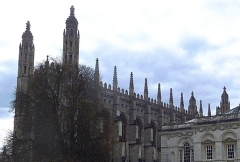 Chapel of Kings College, Cambridge
Chapel of Kings College, CambridgeCAMBRIDGE IS A CITY which I have visited often since I was a child. My first recollection of the place was visiting Gonville and Caius College to meet my father’s long-term collaborator, the Hungarian born economist Peter Bauer (1915-2002). Later, after 1965, during my childhood and adolescence, we used to visit Cambridge to spend time with my father’s friend from his student days in Cape Town (South Africa), the social scientist Cyril Sofer (died 1974) and his wife Elaine. At first, I used to visit them with my family and when I was in my teens, I used to stay with them in their large Victorian house near Selwyn College. It was Elaine, who first introduced me to the joys of the drink known as ‘Bloody Mary’.Further travels to Cambridge followed when a childhood friend of mine attended Clare College to study for his bachelor’s degree. Through him, I met his good friend, now a well-known writer, Matthew Parris.
Many more visits to Cambridge followed my graduation at University College London in 1973. Although I remained in London to study for a higher degree, some of those who had graduated with me moved to Cambridge to pursue further studies. Three out of the nine of us, who graduated in physiology in 1973, embarked on doctoral theses in the city’s university. One of these was Lopa, who is now my wife. While she was at Cambridge, we were still ‘just good friends’, as the saying goes.
On one of my visits to see Lopa, I stayed in a house in Owlstone Road, which is south of the historic centre of Cambridge. A mattress was set up for me in a ground floor room with a street facing window. The room had been recently occupied by a female student, who had moved elsewhere. This sojourn in the city was during the time when the so-called Cambridge Rapist was assaulting young women, always within their homes, at an alarming rate. He carried out his attacks between October 1974 and April the following year.
Apparently, he followed potential victims to their homes and noted down their addresses in a notebook.The rapist carried out his first rape on the 18th of October 1974. Then another on the first of November, and yet again on the 13th of that month (https://en.wikipedia.org/wiki/Peter_Samuel_Cook). The latter was carried out within Homerton College, now a part of Cambridge University. He struck again on the 13th of February 1975, and then, unsuccessfully, on the 5th of May.
I slept soundly at Owlstone Road when I was staying there for a night or two. One morning, I woke up and saw police vehicles out in the road. It was the 8th of December 1974 and the rapist had raped a woman in the house next door to where I was staying, having broken into its ground floor room, which mirrored that in which I was sleeping. What none of us knew until after the perpetrator, Peter Samuel Cook, was eventually caught during his attack on Owlstone Croft’s nurses’ hostel in June 1975, was that the villain had listed the house in which Lopa was living with some other young ladies in his notebook of potential targets. The young lady who had occupied the room where I spent a couple of nights was in the rapist’s list of future victims.
Cook, who had knifed at least one of his victims, was a violent person and might have been awfully annoyed with me had he broken into the room where I was sleeping and found me, a man, instead of one of his intended female targets. Subsequent visits to the wonderful city of Cambridge have not, I am pleased to relate, been so potentially hazardous. Cook was jailed for life and died in Winchester Prison in 2004.



